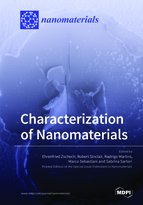Characterization of Nanomaterials: Selected Papers from 6th Dresden Nanoanalysis Symposiumc
A special issue of Nanomaterials (ISSN 2079-4991).
Deadline for manuscript submissions: closed (31 December 2018) | Viewed by 46446
Special Issue Editors
Interests: functional nanomaterials; nanotechnologies; materials analysis; electronic materials; reliability
Special Issues, Collections and Topics in MDPI journals
Interests: advanced and in-situ electron microscopy; material reactions; thin film structures; energy materials; nanotechnology for cancer detection
Special Issues, Collections and Topics in MDPI journals
2. Centre of Excellence in Microelectronics and Optoelectronics Processes of the Institute of New Technologies, CEMOP/UNINOVA, 2829-516 Caparica, Portugal
Interests: functional nanomaterials; paper electronics; advanced functional materials; thin film solar cells; nanotechnologies
Special Issues, Collections and Topics in MDPI journals
Interests: nanoindentation; FIB; residual stress; thin films; fracture; nanomechanics
Special Issues, Collections and Topics in MDPI journals
Interests: nano-scale materials; spectroscopy; neutron scattering; materials for energy storage and conversion
Special Issues, Collections and Topics in MDPI journals
Special Issue Information
Dear Colleagues,
The characterization of nanomaterials is of high scientific interest and of increasing industrial relevance, particularly for applications to high-tech products. This Special Issue of Nanomaterials, “Characterization of Nanomaterials”, aims to cover a broad range of subjects in the field of nanoanalysis and materials characterization along the whole value and innovation chain. It focuses on the development and application of microscopy, spectroscopy, and diffraction techniques. New research results in disruptive nanoanalysis techniques will be reported, and novel solutions in the field of materials characterization for process and quality control will be shown. This Special Issue will include original research articles and comprehensive review articles covering the most recent progress and new developments in the nano-scale characterization of materials.
The papers in this Special Issue are based on selected presentations at the 6th Dresden Nanoanalysis Symposium which was held in Dresden on 31 August 2018. It brought together scientists and engineers from universities, research institutions, equipment manufacturers, and industrial end-users. The discussions and interactions between the stakeholders will help to identify gaps in the fields of advancing nanoanalysis and materials characterization and to propose actions to close them and to support the industrial exploitation of innovative materials.
Prof. Dr. Ehrenfried Zschech
Prof. Dr. Robert Sinclair
Prof. Dr. Rodrigo Martins
Prof. Dr. Marco Sebastiani
Prof. Dr. Sabrina Sartori
Guest Editors
Manuscript Submission Information
Manuscripts should be submitted online at www.mdpi.com by registering and logging in to this website. Once you are registered, click here to go to the submission form. Manuscripts can be submitted until the deadline. All submissions that pass pre-check are peer-reviewed. Accepted papers will be published continuously in the journal (as soon as accepted) and will be listed together on the special issue website. Research articles, review articles as well as short communications are invited. For planned papers, a title and short abstract (about 100 words) can be sent to the Editorial Office for announcement on this website.
Submitted manuscripts should not have been published previously, nor be under consideration for publication elsewhere (except conference proceedings papers). All manuscripts are thoroughly refereed through a single-blind peer-review process. A guide for authors and other relevant information for submission of manuscripts is available on the Instructions for Authors page. Nanomaterials is an international peer-reviewed open access semimonthly journal published by MDPI.
Please visit the Instructions for Authors page before submitting a manuscript. The Article Processing Charge (APC) for publication in this open access journal is 2900 CHF (Swiss Francs). Submitted papers should be well formatted and use good English. Authors may use MDPI's English editing service prior to publication or during author revisions.
Keywords
- materials characterization
- nanoanalysis
- electron microscopy
- X-ray microscopy
- nanomechanics
- spectroscopy
- diffraction











